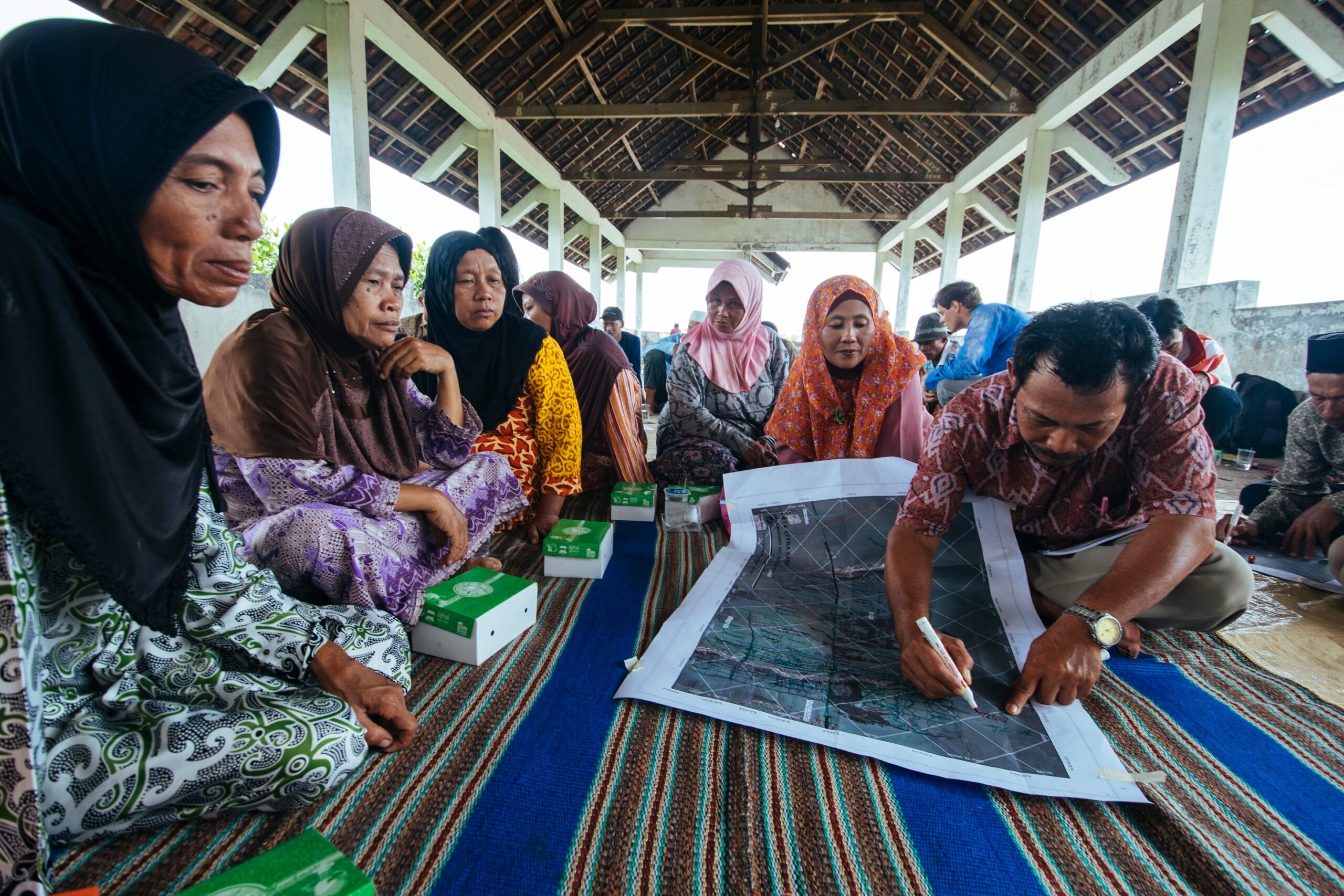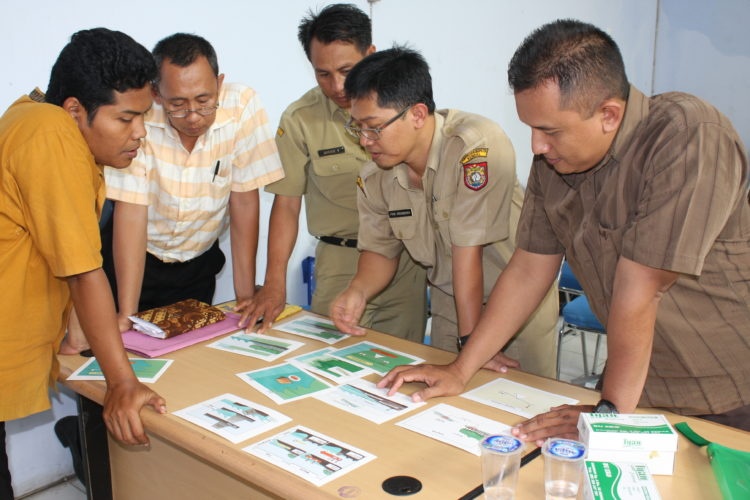Training of local inhabitants for self-supportiveness (Objective 3)
Initiation (training)
In Indonesia most farmers learned aquaculture through trial and error. Knowledge transfer by services was limited and not always based on facts, in particular when advice was given by salesmen. This is one of the factors explaining the low and volatile yields of the coastal brackish water ponds (tambak) and contributing to the near disappearance of mangroves.
It is estimated that in Northern Java more than 30 million people are subjected to increased coastal vulnerability due to unsustainable land use practice. Therefore, the flagship project in Demak also serves to inform and inspire coastal zone managers from government and private sector and help them include the Building with Nature approach in their urban and rural development programmes. This contributes to replication and scaling up of Building with Nature across Indonesia. For this the project aims for BwN solutions to be embedded in policies and plans for sustainable development and coastal security in Demak, Central java and the national level. In the initiation phase an overview of these policies and plans has been developed.
Planning & Design (training)
Using the field school approach, the Building with Nature Initiative intends to stimulate meaningful stakeholder participation to ensure the long-term success, and to build farmer’s capacity to make aquaculture beneficial and ecologically sound. The so-called Coastal field schools (CFS) are extensive year-long learning programmes that enable communities to advance their livelihoods by sustainably managing their coastlines and its natural resources. Such programmes can be implemented by public and or private parties.
In the case of Building with Nature Indonesia project, the CFS compares organic low external input sustainable aquaculture (LEISA) with a traditionally managed pond. Gradually the CFS participants will learn to: manage their pond and its surrounding agro-ecosystem, use critical thinking skills at both pond and community level, engage in mangrove’ restoration for coastal protection and biodiversity, and discover new opportunities or solutions to new local problems. After the training, farmers can enhance their income from milkfish and shrimp aquaculture to underpin efforts to restore mangroves for coastal safety.
Implementation (training)
CFS Key Characteristics
A CFS consists of regular group meetings at agreed intervals during a full cropping season and is field based. The primary learning material is the farming system. The training principle is not teaching, but facilitation of hands-on and discovery-based learning that enable farmers to be active learners and expert of their own field. The integrated and participant-defined curriculum which cover the full cycle of production.

In every CFS, participants conduct a Participatory Comparative Experiment (PCE) with a demo-pond applying LEISA and a traditional pond management (control). One CFS learning unit consists of 20 to maximum 30 coastal villagers who share a common interest (same livelihood activity) and come from the same or nearby area. Each group should be of mixed socio-economic background regarding gender, literacy, and economic or other strata levels. Such mixed composition will enable peer learning and empower the more vulnerable members.
Bio-rights incentive mechanism for community engagements
The engagement of local people is managed on basis of the financial incentive mechanism called Bio-rights, which reconciles economic productivity with environmental conservation and restoration measures. In return for active engagement in conservation and restoration measures, communities receive (financial) support to develop sustainable livelihoods that will generate income. So, the communities were not paid for their labour in erecting the permeable barriers. Instead, they received loans for development projects using coastal resources, such as improving the productivity of their fish ponds and providing facilities for tourists.
In the case of Demak this translates into coastal safety measures on the one hand and sustainable aquaculture on the other hand. In 2017 Bio-rights contracts were negotiated with 10 community groups, representing 300 villagers. Legal contractual agreements are set up with community groups, rather than with individuals, and are witnessed by the village government. All communities have agreed to convert some ponds into mangroves to avoid further erosion, which was previously deemed impossible.
Operation and Maintenance (training)
Community engagement
‘Involvement of local people managed on basis of bio-rights mechanism’

Bio-rights is a financial incentive mechanism that reconciles economic productivity with environmental conservation and restoration measures. In return for active engagement in conservation and restoration measures, communities receive (financial) support to develop sustainable livelihoods that will generate income.
The Demak District Government has allocated budget to support the local government financially for the maintenance of permeable structures for the coming 3 years to be carried out by community groups nearby the structures. Budget has also been allocated by district and village governments for mangrove rehabilitation and aquaculture revitalisation.
The 10 Demak community groups, which have supported BwN measures are now organised in an ocean management forum called Bintoro (see photo of meeting above). This allows networking with the government and is a mechanism to receive funding to ensure sustainability of Building with Nature interventions.
Capacity building
One of the key initiatives of the programme is to support the development of an Indonesian Building with Nature Forum in which the government, knowledge institutes, private sector, NGO´s and communities collaborate to build up and share Building with Nature knowledge and experience in Indonesia. The Forum is already providing helpdesk facilities, offering trainings, hosting learning events and organising field visits and exchange visits.
A training programme, addressing Building with Nature measures has been developed and executed, reaching local governmental agents, coastal managers at different regional levels and local trainers such as universities and research institutes
A new training and awareness programme in collaboration with 10 knowledge institutes and universities, has been established to integrate Building with Nature in their curricula will help build the necessary capacity to implement Building with Nature at scale. In January 2020 the last training of trainers took place, accompanied by signing of a Memorandum of Agreement with several institutes.
Embedding in policies and planning
Works have been initiated to integrate BwN approaches and practices in policies and planning, on national, regional, district and village level.
On national level:
The National mangrove Ecosystem management Strategy has been endorsed by the Coordinating Ministry of Economy. New Action Plans and funding will offer opportunities for Building with Nature.
The Coordinating Ministry of Marine and Investment Affairs has included Hybrid Structures approach as one of the measures for coastal protection in the National Development Plan 2020-2024. This is key to have pilots in the field, and to allow budget to all ministries for implementing this. The term is however limiting the application of BwN in other settings, so may need to be broadened.
Building with Nature has been included in the overall Indonesian annual report to the Sendai Framework for Disaster Risk REduction
Building with Nature Indonesia case in Demak has been identified as a best case for coastal measures to be included in the Indonesia Climate Change Adaptation Action Plan (the RAN-API) – work in progress
On regional level:
Central Java established an Integrated Coastal Zone Management task force in 2014 for strengthening institutional management of coastal areas. Currently, Central Java Province has a North Coast Java Coastal Restoration and Conservation project under the MoU Water mechanism with The Netherlands. The activities focus on capacity building on ICZM, one of which is the BwN approach.
In cooperation with the Marine and Fisheries Agency of the Central Java Province, it has been encouraged for mangrove areas to be used as conservation areas (Betahwalang Village, Demak District) in the Coastal Zoning Plan of Central Java Province.
Together with the Central Java mangrove working group, through the Central Java Governor’s Office a strategy for mangrove management areas in Central Java Province has been established, where one of the policies is to establish mangrove areas as essential ecosystem areas.
On district level:
The Master plan for sustainable development of Demak district – including Building with Nature measures has been developed with and endorsed by Taskforce Integrated Coastal Zone Management led by planning agency of Central Java and involving all relevant stakeholders.
In cooperation with Bappeda Demak, the Master Plan of Demak coastal management has in 2015 been developed, in which BwN is one of the suggested approaches in managing several coastal problems.
On village level:
Village development plans and regulations on land use rights, protected areas and coastal zone management developed and adopted by 10 communities and formalized under village government. It has already resulted in enhanced government support for maintenance of permeable structures, mangrove rehabilitation and aquaculture.
Connecting, Replication and Up-scaling
Building with Nature is innovative and site specific and it operates in areas where the understanding of systems is limited and where changes are dynamic. Therefore, a strategy of learning-by-doing has been adopted, and knowledge and lessons learned are shared widely to support the sound replication of the chosen approach. This is done through capacity building, knowledge exchange and embedding in policies and planning.
To ensure that policies translate into sound implementation on the ground we are facilitating the development of Building with Nature landscape propositions. Depending on the hazard and the biophysical and socio-economic setting the Building with Nature solutions can be very different, involving an optimal mix of green and grey infrastructure.
Largescale replication of permeable structures by the Ministry of Marine Affairs and Fisheries worth 1.4 million EUR (see technical measures). MMAF has included hybrid structures as a priority in its programme, and has included beach belt restoration and hybrid structures in its Sea space management program in new locations.
From 2015 – 2019 government partner MMAF has funded a marine spatial management program to restore eroding coastlines with up to 25 km of permeable structures placed throughout Indonesia (of which 4,4 km in Demak) worth ~2.5 million EUR, showing great uptake of the approach. In settings with much less subsidence the structures are working properly; trapping sediment and restoring a mangrove foreshore.
Government partner PUSAIR, the research department of the Ministry of Public Affairs and Housing has developed and tested new permeable structure designs, which is crucial for uptake by the Ministry. PUSAIR secured 1.1 m EUR for research to monitor impact and further enhance the approach and produced a guideline on Hybrid Engineering, to be accepted as a national guideline.
